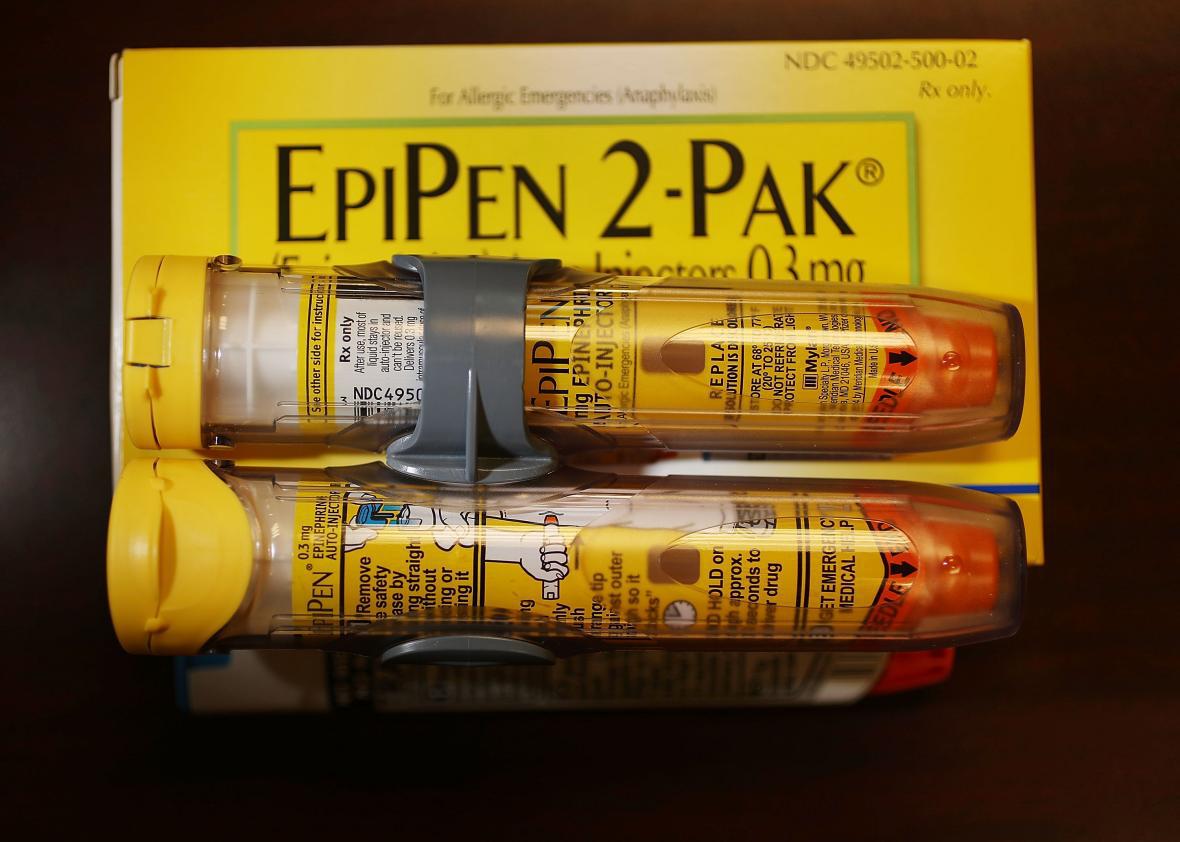After drawing public wrath and congressional scrutiny over its decision to raise the price of life-saving EpiPens to about $600 a pack, Mylan is trying to save its image. On Thursday the pharmaceutical company announced it would give a $300 coupon to lower- and middle-income customers who have to pay for the device out of pocket because they lack health coverage or have a high-deductible insurance plan (previously, it offered a $100 discount card). Meanwhile, CEO Heather Bresch appeared on CNBC’s Squawk Box to try to quell some of the outrage by laying blame for the price hike at the feet of our “broken” health care system.
It was not an especially convincing performance.
Before we get into Bresch’s interview, a word about the coupon. Even at half price, EpiPens—which stop allergic reactions by injecting epinephrine into users—are still far more costly today than a few years ago. (Full disclosure: I carry one myself). When Mylan purchased the device in 2007, a pack cost about $100. Giving patients a 50 percent break after increasing prices 500 percent is not exactly a sweeping act of charity, even if it does help some families erase their entire co-pays. It’s also worth noting that this latest move is very much in Mylan’s own self-interest. Pharmaceutical companies don’t typically make their profits off of middle-income patients who have to choose between gas money and their kids’ allergy meds; rather, they count on big payments from insurers, who pass it on to consumers in the form of higher premiums. Obscuring the true cost of drugs from the public through discounts and donations is part of the game pharma manufacturers play to avoid accidentally causing an uproar of the sort Mylan has witlessly stumbled into—which is to say, Bresch and her fellow executives were negligent in not offering that coupon sooner.
And now about that CNBC spot. Mylan’s main talking point seems to be that journalists have erred by focusing on the EpiPen’s list price of $608 per pack. In reality, few patients actually pay that cost, the company notes, because they are either insured or receive a discount. Meanwhile, Mylan itself only makes about $274 on each sale—the rest goes to other companies in the drug supply chain, including wholesalers, pharmacies, and pharmacy benefit managers. It even put together a handy flow chart for PR purposes.

Mylan Pharmaceuticals
Bresch echoed this point in her interview with CNBC’s Brian Sullivan. But then things got a bit weird, as the CEO declared that she too was outraged by the high cost of America’s prescription drugs.
Brian Sullivan: But surely you must understand the outrage. Somebody I talked to last night said people are outraged because it seems outrageous. That the American Medical Association has said this is basically the same product it was in 2009. And yet the price has gone up 3 or 400 fold.
Heather Bresch: Look, no one’s more frustrated than me. I’ve been in this business for 25 years…
Sullivan: But you’re the one raising the price, how can you be frustrated?
Bresch: My frustration is there’s a list price of $608. There is a system. I laid out that there are four or five hands that the product touches and companies that it goes through before it ever gets to that patient at the counter. No one, everybody should be frustrated, I am hoping that this is an inflection point for this country. Our health care is in a crisis. It’s no different than the mortgage and financial crisis back in 2007. This bubble is going to burst.
This would all make more sense—and feel less hollow—if Mylan were not actually profiting from its price increases. In that case, it could fairly argue that leechlike middlemen were pushing up costs while allowing manufacturers to take the blame. And, to be sure, there is some of that going on. As the New York Times notes, Mylan upped EpiPen list prices by about 30 percent in 2015, yet didn’t record any additional revenue. That suggests pharmacy benefit managers—which deal with prescription drugs for insurers and other clients—managed to negotiate some fairly large discounts. But make no mistake, Mylan has cashed in. Per the Times:
In other years, though, sales of EpiPen rose by larger amounts and Mylan seemed to have retained about half the extra revenue that would be expected from its list price increases and prescription growth, according to Umer Raffat, an analyst at Evercore ISI. Even in 2015, he said, the rebates were kept by insurers and pharmacy benefit managers, and were not seen in lower prices paid by consumers.
“Someone definitely got that,” Mr. Raffat said of the rebates. “Who is that? It wasn’t passed on to customers.”
If you want to boil it down even further, think of it this way: Mylan is crying that it only gets to keep $274 each time someone buys an EpiPen pack. That’s still nearly three times the list price when it acquired the product.
So, I am sure Bresch truly is frustrated by the fact that Mylan is taking most of the heat for price increases when other companies are profiting from them, too. But that doesn’t excuse her company’s own role. As the Times reports, the manufacturer appeared to be increasing the EpiPen’s price to squeeze a few last inflated profits from the product before a generic competitor landed on the market. In a twist, though, the Food and Drug Administration rejected the generic, and the EpiPen’s one major alternative was pulled from pharmacies due to reliability issues, leaving Mylan with an unexpected monopoly that it is now profiting from. Is it the company’s fault the government nixed its big new competitor? No. But nobody forced Mylan to jack up prices for one last big sales push.
It all almost makes you miss Martin Shkreli; at least he was happy to own his villainy.
